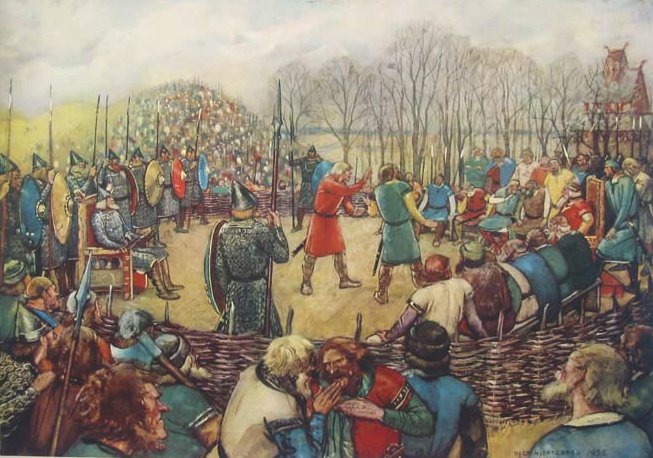Viking Law And Order Was Based On The Thing System
A. Sutherland - AncientPages.com - It's an ancient fact that Vikings were fierce warriors, and they did plunder a lot. However, what could be more well-known is that even though there was no written law and only rune writing existed at the time; the ancient Viking society had a sophisticated government and law system.
A Germanic Assembly, by Charles Rochussen. Source - Public Domain
In the pre-Christian clan-culture of Scandinavia, the members of a clan were obliged to avenge injuries against their dead and mutilated relatives. As the result, those involved were frequently involved in a prolonged and unpleasant dispute or quarrel. This kind of action was necessary for solving a problem.
Viking law and order was based on the so-called thing system. People believed it was better than having disputes settled by duel or family feuds that could lead to unnecessary injuries. In the Viking society, all free men, women and disabled people were allowed to attend its meetings.had the right to conduct revenge killings. You could kill somebody in public without suffering severe consequences because you were honest, did not hide your actions, and allowed others to react.
It was essential to take responsibility for the murder, not run away, and pay the fines. The same applied to killing somebody in a fight.
Traditionally, feuding was often seen as the most common form of conflict resolution used in Viking society. Tribal feuds often contributed with reducing and avoiding social disorder in North-Germanic cultures. Additionally, they played an significant role as forums for power display, marriage alliances, honor isues, and inheritance settlements.
Administrative organization in Sweden's thing sites (similar to those in Norway) began to change in the late tenth and eleventh century. It was time of the power struggle caused byt the rising Christian royal power in the process of establishing itself and the old, local magnate families still attempting to maintain power.
A place for an assembly - a thingstead. Illustration by Hjortzberg, O. 1932 - Norstedt und Söner/Westermann/Esselte/Stockmann, P., Stockholm - Public Domain
Runic inscriptions at thing sites are considered the most valuable source of our knowledge about the battle for power between the king and local magnates that took place. Important power statements were recorded in stone.
Swedish assembly sites had a number of specific features that usually included large natural or oftan man-made mounds, often burial mounds, rune-stones, and communication routes - crossings between roads by land (or water) to allow greater gatherings.
Mainly in Scandinavia, large runestones decorated with inscriptions informed about a local family's attempt to claim supremacy are common features of thing sites.
The Thing Took Place At Regular Intervals
The governing assembly legislated, elected chieftains and kings, and judged. It was made according to the law, which was memorized and recited by the "lawspeaker" (the judge). The thing's negotiations were presided over by the lawspeaker and the chieftain or the king.
While the things were not democratic assemblies in the modern sense of an elected body, they were built around ideas of neutrality and representation, effectively representing the interests of largernumbers of people. In Norway, the thing was a space where freemen and elected officials met and discussed matters of collective interest, such as taxation.
Some scholars say that the things were dominated by the most influential members of the community, the prominent heads of clans and representatives of wealthy families, other scholars describe how every free man could put forward his case and share his opinions.
These things also served as courts of law, and if one of the smaller things could not reach agreement, the matter at hand would be brought to one of the bigger things, which included larger areas
Towards the end of the Viking age, royal power became centralized and the kings began to strengthen power and control over the assemblies. As a result, things lost most of their political role and began function as courts in the later Middle Ages.
 Germanic thing, drawn after the depiction in a relief of the Column of Marcus Aurelius (193 CE). Image upploader: Wolpertinger - PublicDomain
Germanic thing, drawn after the depiction in a relief of the Column of Marcus Aurelius (193 CE). Image upploader: Wolpertinger - PublicDomain
In late medieval times, the Thing was made up of twelve representatives for the farmers, free-holders or tenants.
A Thing was the governing assembly made up of the free people of the community. Each community had its own independent Thing where all free Vikings could gather to make law, resolve disputes and make decisions. The meeting place was called a thingstead.
The Thing had meetings that could sometimes last several days. Each Thing had a law speaker who would recite the law from memory. Although all free men of the community were entitled to voice their opinion, it was still up to the law speaker and the local chieftain to judge and settle the cases of dispute they heard.
To be summoned to the Thing was regarded as a very hostile act; therefore, the parties always tried to reach an agreement.
Those who faced a trial at the Thing knew the verdict could devastate their lives. People found guilty were either fined, declared semi-outlaw, or entirely outlawed. To be an outlaw was a dreadful punishment for a Viking, as it resulted in being banished from society and having one's property confiscated.
A person declared an outlaw by the Thing could never expect to receive help from anyone. Isolated from society, outlaws faced loneliness and could be killed at any time by anyone. The only way to survive with dignity was to escape abroad or settle in a different location where they were not known.
According to the rules and regulations of the Thing, all free men, including the kings and chieftains, must respect the law. The Thing was considered a democratic system, and everyone except enslaved people and exiles was considered a citizen.
Written by – A. Sutherland - AncientPages.com Senior Staff Writer
Updated on Aug 20, 2023
Copyright © AncientPages.com All rights reserved. This material may not be published, broadcast, rewritten or redistributed in whole or part without the express written permission of AncientPages.com
Expand for referencesMore From Ancient Pages
-
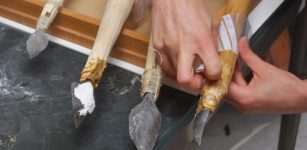 Oldest Known Spearthrowers Found At 31,000-Year-Old Archaeological Site Of Maisières-Canal
Archaeology | Nov 6, 2023
Oldest Known Spearthrowers Found At 31,000-Year-Old Archaeological Site Of Maisières-Canal
Archaeology | Nov 6, 2023 -
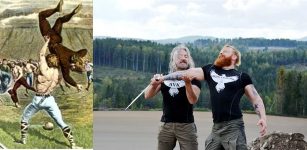 Glima – Ancient Martial Art Practiced By The Vikings Is Still Popular Today
Ancient Traditions And Customs | Mar 7, 2017
Glima – Ancient Martial Art Practiced By The Vikings Is Still Popular Today
Ancient Traditions And Customs | Mar 7, 2017 -
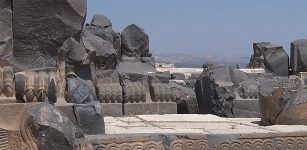 Unsolved Mystery Of The Giant Footprints Outside The Ain Dara Temple
Featured Stories | Jun 7, 2014
Unsolved Mystery Of The Giant Footprints Outside The Ain Dara Temple
Featured Stories | Jun 7, 2014 -
 Impressive Study Highlights Female-Led Migration Into Bronze Age Orkney And Wins Prestigious Award For 2023
Archaeology | Apr 4, 2023
Impressive Study Highlights Female-Led Migration Into Bronze Age Orkney And Wins Prestigious Award For 2023
Archaeology | Apr 4, 2023 -
 Seven Fires Prophecy Of The Anishinaabe People And The Future Of The Turtle Island – Are Humans Standing At The Crossroads?
Featured Stories | Feb 14, 2019
Seven Fires Prophecy Of The Anishinaabe People And The Future Of The Turtle Island – Are Humans Standing At The Crossroads?
Featured Stories | Feb 14, 2019 -
 Evidence Mendel Discovered The Laws Of Inheritance Decades Ahead Of His Time
Archaeology | Jul 12, 2022
Evidence Mendel Discovered The Laws Of Inheritance Decades Ahead Of His Time
Archaeology | Jul 12, 2022 -
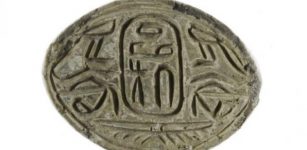 Hyksos: 15th Dynasty Rulers Of Ancient Egypt, Were An Internal Takeover
Archaeology | Jul 15, 2020
Hyksos: 15th Dynasty Rulers Of Ancient Egypt, Were An Internal Takeover
Archaeology | Jul 15, 2020 -
 Was Biblical Adam A Giant Who Emerged From An Underground World?
Biblical Mysteries | May 24, 2018
Was Biblical Adam A Giant Who Emerged From An Underground World?
Biblical Mysteries | May 24, 2018 -
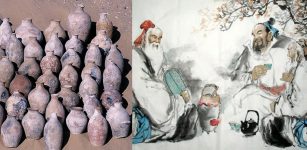 Ancient Civilizations Invented Alcohol 10,000 Years Ago
Ancient History Facts | Sep 13, 2016
Ancient Civilizations Invented Alcohol 10,000 Years Ago
Ancient History Facts | Sep 13, 2016 -
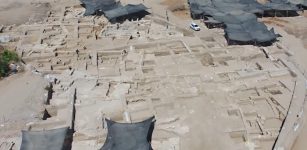 World’s Largest Wine Factory From The Byzantine Period Unearthed In Yavne
Archaeology | Oct 14, 2021
World’s Largest Wine Factory From The Byzantine Period Unearthed In Yavne
Archaeology | Oct 14, 2021 -
 Bezvodovka: Little Known Ancient Solar Observatory In Ukraine Reveals Its Secrets
Archaeoastronomy | Jan 4, 2017
Bezvodovka: Little Known Ancient Solar Observatory In Ukraine Reveals Its Secrets
Archaeoastronomy | Jan 4, 2017 -
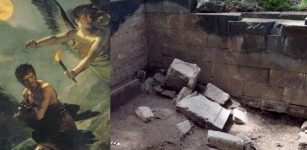 Temple Dedicated To Goddess Nemesis Discovered Under Ancient Theater In Greece
Archaeology | May 20, 2019
Temple Dedicated To Goddess Nemesis Discovered Under Ancient Theater In Greece
Archaeology | May 20, 2019 -
 Unknown Prehistoric Henge Site Detected Near Famous Newgrange In Ireland’s East Coast
Archaeology | Jul 13, 2018
Unknown Prehistoric Henge Site Detected Near Famous Newgrange In Ireland’s East Coast
Archaeology | Jul 13, 2018 -
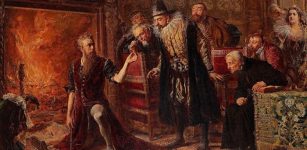 On This Day In History: England’s Act Against Multipliers Signed Into Law – On Jan 13, 1404
News | Jan 13, 2017
On This Day In History: England’s Act Against Multipliers Signed Into Law – On Jan 13, 1404
News | Jan 13, 2017 -
 Sole Survivor Recalls An Incredible Unexplained Mountain Mystery
Featured Stories | Aug 7, 2023
Sole Survivor Recalls An Incredible Unexplained Mountain Mystery
Featured Stories | Aug 7, 2023 -
 How Many Ice Ages Has The Earth Had, And Could Humans Live Through One?
Featured Stories | Sep 26, 2022
How Many Ice Ages Has The Earth Had, And Could Humans Live Through One?
Featured Stories | Sep 26, 2022 -
 Mysterious Relics Can Retrieve Leonardo da Vinci’s DNA And Provide New Information About The Great Renaissance Man
Archaeology | Apr 22, 2017
Mysterious Relics Can Retrieve Leonardo da Vinci’s DNA And Provide New Information About The Great Renaissance Man
Archaeology | Apr 22, 2017 -
 Kingdom Of Mitanni: Forgotten For Millennia But Once Great Power Of Ancient West Asia In 2000 BC
Featured Stories | Jun 20, 2023
Kingdom Of Mitanni: Forgotten For Millennia But Once Great Power Of Ancient West Asia In 2000 BC
Featured Stories | Jun 20, 2023 -
 Mystery Of Pharaohs And Gods With Two Left Or Two Right Hands
Featured Stories | Oct 20, 2018
Mystery Of Pharaohs And Gods With Two Left Or Two Right Hands
Featured Stories | Oct 20, 2018 -
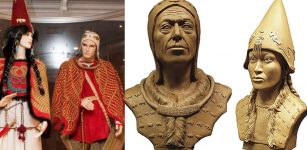 Stunning Facial Reconstruction Of ‘Siberian Tutankhamun’ And His ‘Queen’ Who Died 2,600 Years Ago
Archaeology | Jan 12, 2021
Stunning Facial Reconstruction Of ‘Siberian Tutankhamun’ And His ‘Queen’ Who Died 2,600 Years Ago
Archaeology | Jan 12, 2021


